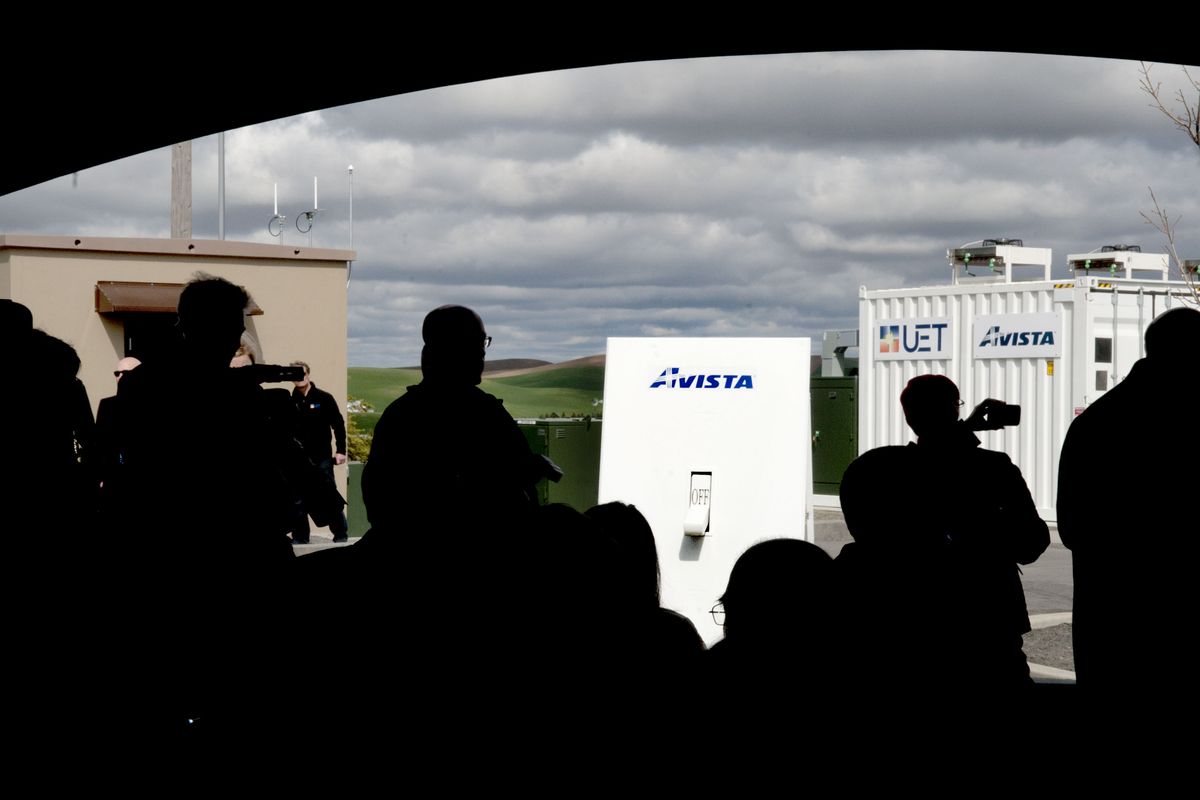Schweitzer Labs puts ‘game-changing’ battery power to test in Pullman

PULLMAN – If Schweitzer Engineering Laboratories’ manufacturing plant loses power during an outage, the company can turn to huge batteries on its campus for electricity.
The batteries could supply enough power to run most of the factory’s operations for about three hours.
A crowd of dignitaries, including Gov. Jay Inslee, turned out for the batteries’ activation on Thursday, recognizing the role they could play in solving a renewable energy conundrum.
The Western landscape holds enormous potential for wind and solar development, but utilities don’t have a cost-effective way to store that energy for later use, when the wind has died down and the sun isn’t shining. As a result, utilities have to build backup electrical generation – often carbon-emitting coal plants or gas-fired turbines.
“What we’re doing here is game-changing,” said Heather Rosentrater, Avista Utilities’ director of engineering. “When the wind is blowing, and the sun is shining, we’ll be able to store that abundant resource.”
Years of research have gone into the Vanadium Redox Flow batteries, which are being used in the $7 million Pullman test project. The 1-megawatt batteries have the largest storage capacity to date in North America. If they aren’t running Schweitzer Engineering’s factory, they could provide enough energy to meet the electrical needs of about 100 Pullman households.
Another way to think of it: the batteries can store the electrical output from one wind turbine, said David Whitehead, Schweitzer Engineering’ vice president of research and development.
That might sound small, he said, but it’s an enormous step forward in battery technology: “This is large-scale energy storage.”
Inslee compared the significance of the battery-storage work to the 1930s construction of Grand Coulee Dam, which remains North America’s largest hydropower producer.
“We’re laying the groundwork for the most transformative change in the electric grid system in 60 years,” Inslee said. “When we flip the switch today, we won’t just be making clean energy. We’ll be making a commitment to future generations.”
The batteries generating so much excitement are housed in two rows of metal shipping containers in Pullman’s industrial park. With the wind gusting across the Palouse, their initial charge probably included some electricity from nearby wind turbines in Rosalia.
Multiple companies and government agencies are involved in the battery storage project.
The U.S. Department of Energy funded the research for the batteries at the Pacific Northwest National Laboratory in Richland. The technology was licensed to UniEnergy Technologies of Mukitelo, Washington, which manufactured them.
Avista is putting $3.8 million into the Pullman test, which is also funded by a $3.2 million grant from the state’s Clean Energy Fund.
Over the next 18 months, Schweitzer Engineering will provide the real-world application for testing how the batteries work. The company produces sophisticated equipment for the electrical grid, which is sold in 147 countries.
During power outages, Schweitzer will use the batteries as a backup electrical source instead of diesel-fired generators. Electricity from the batteries is available almost instantly, while the generators take about 15 minutes to fire up, Whitehead said.
During extremely hot or cold days, when demand for electricity is high, Avista will also draw on the energy stored in the batteries to level out spikes in demand.
The Snohomish County Public Utilities District also is experimenting with battery storage. Testing of lithium ion batteries is underway by the utility, but those batteries store less energy. Snohomish PUD is planning a test with UniEnergy batteries used in Pullman.
“I think it’s interesting that these are being built,” said Tom Karier, Eastern Washington represenative for the Northwest Power and Conservation Council. “It’s the missing puzzle piece for clean energy resources in the Northwest. With storage, we’ll be able to meet the peak electrical requirements, which wind and solar can’t do now.”
Craig Lewis traveled from Menlo Park, California, to see the project. He’s the executive director of Clean Coalition, which advocates for increased use of renewable energy.
In California, state law requires utilities to start buying batteries that can store renewable energy. The state already gets about 23 percent of its electricity from wind, solar, biomass and geothermal production. The goal is to better integrate that electricity into the power grid, he said.
“We want to avoid building new fossil fuel generation,” Lewis said.